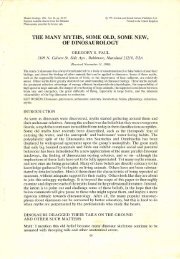HUNTERIA - Gregory S. Paul
HUNTERIA - Gregory S. Paul
HUNTERIA - Gregory S. Paul
You also want an ePaper? Increase the reach of your titles
YUMPU automatically turns print PDFs into web optimized ePapers that Google loves.
Russell, D., Beland, P. and McIntosh, ].S. 1980. Paleoecology<br />
of the dinosaurs ofTendaguru (Tanzania). Memoirs Societe<br />
Geologie Francais 59 (139):169-175.<br />
Spinar, Z.v. and Burian, Z. 1972. Life Before Man. New<br />
York: American Heritage Press.<br />
Stokes, W.L. 1985. The Cleveland-Lloyd Dinosaur Quarry,<br />
window to the past. U.S. Government Printing Office<br />
1-27.<br />
The neck of B. (G.) brancai HMN JII is about 0.3 m<br />
shorter than the 9.3 m neck of the primitive, 9 ton diplodocid<br />
Mamenchisaurus hochuanensis PMNH 3 (Young and<br />
Chow, 1972). It is likely that Supersaurus also had a longer<br />
neck than the largest Brachiosaurus.<br />
Martin (1987) restores the neck of the sauropod<br />
Cetiosaurus as barely able to reach the ground, rise above<br />
the height of the shoulders, or swing to either side. That such<br />
a neck of 14 bird-like vertebrae would be far less flexible than<br />
the giraffe's neck of 7 vertebrae is untenable. A high number<br />
of vertebrae directly implies great flexibility, since a stiff long<br />
neck is better achieved by lengthening a few vertebrae, as in<br />
the giraffe. Errors in Martin's restoration include a maximum<br />
raised neck posture that is really its normal, neutral S curve,<br />
zygapophyses that are virtually immobile, and an average of<br />
only 1.4° of motion from the centerline between each cervical.<br />
Instead, the sauropod cervical combination of ball and socket<br />
centra articulations with large zygapophyses was designed to<br />
maintain articulation over a much greater range of motion<br />
than Martin shows, especially when the bony joint areas were<br />
expanded by cartilagenous surfaces. Exactly how much more<br />
I am not sure, what one can learn from dry bone manipulations<br />
or paper studies is useful, but not necessarily true to life.<br />
Sauropod and giraffe cervicals are remarkably similar; study<br />
of the latter might prove helpful to the problem. Note that<br />
a modest 12° or so of rotation between successive segments<br />
in 6 posterior cervicals would allow the sauropod head to reach<br />
GREGORY S. PAUL<br />
NOTES ADDED IN PROOF<br />
Van Valen, L. 1969. What was the largest dinosaur? Copeia<br />
1969:624-262<br />
Watson, ].W. and ZaUinger, R.F. 1960. Dinosaurs and Other<br />
Prehistoric Reptiles. New York: Golden Press.<br />
. high up. This mobility is plausible since many mammals can<br />
do the same with only 7 cervicals. The extreme neck<br />
inflexibility Martin restores in sauropods is also functionally<br />
illogical, since shorter necked ungulates can reach as far up<br />
and to the side relative to their size. Long necks are an extreme<br />
adaptation, and among land herbivores their only useful<br />
purpose is to increase the vertical reach of high browsers. Low<br />
browsers and grazers invariably have modest necks because<br />
they can always reach what they want by just taking a few<br />
steps towards it.<br />
Contrary to Martin (1987), the ilial pubic penducles of all<br />
sauropods were massive, buttressed from the front and inside<br />
by stout sacral ribs, and well able to bear the mass of a rearing<br />
individual. Note that sauropods only stood, or occasionally<br />
slowly walked, bipedally. They did not incur the stresses of<br />
fast bipedal motion.<br />
PMNH - Beijing Museum of Natural History, Beijing.<br />
Martin, ]. 1987. Mobility and feeding of Cetiosaurus<br />
(Saurischia, Sauropoda) - why the long neck? In: Currie,<br />
P.]. and Koster, E.H. (eds.). Fourth Symposium on<br />
Mesozoic Terrestrial Ecosystems. Drumheller: Tyrell<br />
Museum of Paleontology. pp. 150-155.<br />
Young c.c. and Chow X.]. 1972. On Mamenchisaurus<br />
hochuanensis. Paleontographica Sinica, A., Special Issue<br />
8:1-30<br />
Total cost of production of this paper was donated by Dinamation International, Chris Mays, President.<br />
<strong>HUNTERIA</strong> VOL. II, no. 3, pp. 14, February 19, 1988<br />
-- _









